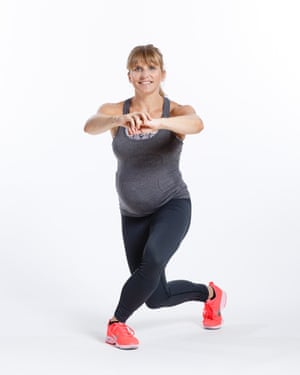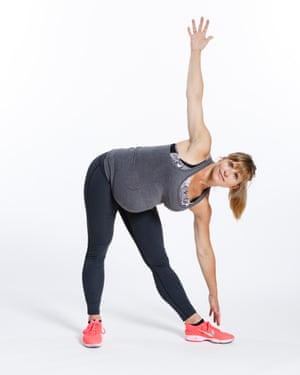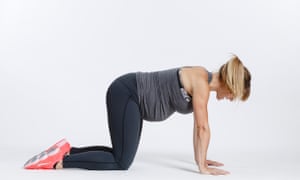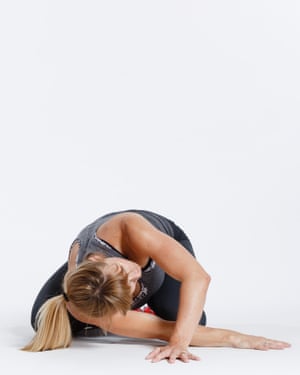‘Stop running, kill the wild swimming and be careful about cycling.” I like my GP – he is a funny, hardworking man, practising in a diverse community with stretched resources. But when I walked into his office, six weeks pregnant, his advice on exercise during pregnancy felt a little like being wrapped in a vacuum bag. I didn’t want to stop exercising. I can’t really afford to stop cycling (thank you Transport for London) and I would genuinely fear for my mental health if I gave up running overnight.
Exercise during pregnancy is controversial. Serena Williams, winner of 23 tennis grand slams, made headlines worldwide on Monday, simply for declaring her plans “to keep exercising for as long as possible while pregnant”. For much of recent history, write the authors of Exercise During the Childbearing Year, “pregnant women were treated as if they had an illness and were subjected to a state of confinement. They were advised to relax, avoid strenuous exertion, and minimise stretching and bending for fear of strangling or squashing the baby”. Even in the first few months, when your body remains bumpless, some people will knit their brow and take a sceptical breath if you say you intend to remain active. You will be warned off lying on your back, swimming anywhere but a pool, lifting anything heavier than a feather and putting any sort of pressure on your joints. But is this advice based on evidence?
Modern scanning techniques, longitudinal studies, improvements in public health and monitoring all mean that we now better understand women’s bodies and the effects of pregnancy. The NHS, the Royal College of Obstetricians and Gynaecologists, the National Childbirth Trust and the National Institute for Health and Care Excellence all recommend moderate exercise during pregnancy, to alleviate or reduce the risk of gestational diabetes, pregnancy-induced hypertension, high gestational weight gain, type 2 diabetes and cardiovascular disease. Yet, according to the charity Tommy’s (which funds research into miscarriage, stillbirth and premature birth), many women still fear that exercise can lead to miscarriage. Tell someone that you are going for a run in even your first trimester and you will be warned to “take it easy” and “be sensible”.
“We go by the principles of Fit: frequency, intensity and time,” says Joan Murphy, co-founder of pregnancy programme Mumhood at London gym Frame. “Reduce the time, distance, weight and how often, but you can keep going. If someone asks ‘can I do this?’ our response is always: ‘Yes,’ followed quickly by: ‘But how does it feel?’”
Murphy’s advice feels like both a licence to behave in a way your body wants and encouragement for when it doesn’t. When she says: “You wouldn’t run a marathon without doing some exercise in preparation, so why go into a marathon labour without getting your body ready?” I find myself slamming my glass on the table and cheering. “If you have a base level of fitness, your body’s used to that,” says Murphy. According to NHS guidelines, you can keep up your normal daily physical activity or exercise for as long as you feel comfortable. There is even some evidence that active women are less likely to experience problems in later pregnancy and labour.
“But there is a list of things you need to be aware of,” warns Murphy. “Stay hydrated, don’t overheat, stop if you feel dizzy. Also, as you get the release of the hormone relaxin, your pelvis will start to move apart and your joints will loosen, so be careful of any impact exercise that will put strain on your hips, knees and ankles. Don’t do anything that really puts you off balance, like skiing or horse riding. This isn’t the time to go for your personal best. This is a time when you have to let go of those expectations. The more you let go, the better it’ll be postnatally.”
Still, there are scores of myths around exercising while pregnant. You may, for example, have heard that exercising on your back after 16 weeks is a no-no. “That’s really old school,” Murphy says, rolling her eyes. “Depending on where the baby is, they could lie on the vein that pumps fresh blood to the heart and stop the blood flow. But when the baby does that – you know. It will be very uncomfortable and you’ll roll over. You will feel if you should be lying on your back. And there are lots of great ways to work on your core without lying on your back, of course. It’s also really important through the whole pregnancy to work on your glutes, because they’re what will hold the pelvis stable. That will help alleviate back pain.”
How about weights? The official advice is to avoid any heavy lifting when pregnant, including children, if you have any. But, as many pregnant women know, this isn’t always practical or desirable. “The risk is pulling muscles; everything is connected in there,” says Murphy, nodding at my stomach. “But strength is more important than anything else in pregnancy. You have to hold this body together. The risk is bringing heavy weights over the head, introducing tension and straining when you’re not used to it. But if you lift weights already then bring it down by 20% as you go through your pregnancy.” By the third trimester, recommended exercises for pregnant women move more into yoga, stretching and practical muscle work to prepare for what is to come.
From experience, the link between physical and mental health – which can become even more important during pregnancy – seems to be the least considered aspect in the broader conversation. The Royal College of Psychiatrists recommends exercise as a key factor in maintaining mental wellbeing during pregnancy, while recent research from the University of Southampton has shown that moderate intensity exercise is associated with lower rates of antenatal depression (which affects around one in 10 women at some point during pregnancy). “We’re all operating on a mental health spectrum and where you sit on that spectrum will change, of course,” says Murphy.
“Fitness can offer you time out, away from your phone, in an environment where you are comfortable, but number one it is about breathing. If you’re feeling stressed or depressed or anxious, you need to breathe properly. And exercise can help you regulate that.”
Curtsy Lunges (thighs/glutes)

1. Stand tall with feet hip-width apart and hands on hips.
2. Keeping your weight on your left foot, take a big step back with your right leg crossing behind your left leg.
3. Lower the back knee towards the floor, keep your back straight and upright. You’re aiming to have both knees at a right angle.
4. Keep your deep core engaged, push back to your start position and repeat on the other side.
Repeat for 10 curtsies on each leg. Rest for 30 seconds and aim for three sets.
Wide squats (glutes/hamstrings/thighs)

1. Stand tall with feet wider than hip-width apart and toes slightly turned out.
2. Push your bottom back and down. You want your weight to be in your heels, for your knees to track in line with your toes and to be able to see your toes in front of your knees.
3. Try to keep your upper body upright, your shoulders back and down and your deep core engaged.
4. To come up, push down through your heels, pull up through your pelvic floor and engage your glutes.
Repeat 10 times, rest for 30 seconds. Aim for three sets.
Triangle pose (thighs/obliques)

1. Start with feet a little wider than hip-width apart. Turn your left foot to the side amd rech your right arm high.
2. Pull through your thighs and engage your deep core by ‘hugging’ that baby into your spine.
3. Push your hips out to the right and come down on the left, looking up towards your right arm and think about lengthening the spine as much as possible. If it strains your neck then look down to the floor.
4. You’re aiming to open the chest as much as possible while keeping your legs strong.
Hold for 30 seconds, return to your start position. Aim for 3 holds on each side.
Box plank (deep core/shoulders)

1. Start on all fours, hands directly under your shoulders, knees directly under your hips.
2. Pull the shoulder blades back and think about ‘hugging’ your baby into your spine to engage your deep core.
3. Tuck your toes under, keep your shoulders steady, lift the knees above the ground and keep the xore strong. Hold for 5-10 seconds before returning knees to the floor.
Repeat 5 times
Thread the needle (shoulders/upper and mid back)

1. Start on all fours, hands directly under your shoulders and knees under your hips
2. As you breathe in, take your right arm up high, turn your head to follow your hand.
3. As you exhale, thread that hand other your other arm and reach your fingers out away from you.
4. Breathing in, take your arm back up high.
5. Continue to flow with your breath, on the 10th time hold the position for five deep breaths. Allow your shoulder to relax on the floor in the threaded position.
Repeat three times on each side.
Source: Read Full Article
